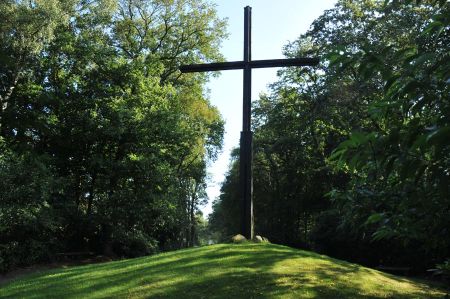Jeverland memorial at Upschloot - Cleverns
- Written by Portal Editor
Actually, we had planned to visit the Blossom Festival in Wiesmoor this year, which is well-known far beyond the country's borders.
Unfortunately, the stormy, really wet and cold weather on the weekend of the event put a spanner in the works, so we postponed this visit to next year.
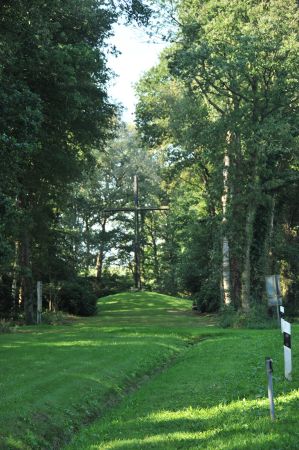 Coming from Jever, we had passed the small village of Cleverns and a little later Sandelermöns a few days later, again with an almost cloudless sky, when we came across a huge wooden cross on the left of the L813 road, which caught our attention. Since there was also a parking lot directly opposite the wooden cross, we stopped to take some photos that were later to be used for further research. Only now did the size of the entire facility become clear, which one would almost have passed without paying attention. The entire green area made a well-kept impression with closely mowed lawns and off-road footpaths. We use the footpath that appeared almost invisible behind the dense forest and came across the first boulders that had the engraved place names of local villages and localities (Hooksiel, Sillenstede, Sengwarden, Jever, etc.). Now our interest was really aroused as to what these boulders could mean.
Coming from Jever, we had passed the small village of Cleverns and a little later Sandelermöns a few days later, again with an almost cloudless sky, when we came across a huge wooden cross on the left of the L813 road, which caught our attention. Since there was also a parking lot directly opposite the wooden cross, we stopped to take some photos that were later to be used for further research. Only now did the size of the entire facility become clear, which one would almost have passed without paying attention. The entire green area made a well-kept impression with closely mowed lawns and off-road footpaths. We use the footpath that appeared almost invisible behind the dense forest and came across the first boulders that had the engraved place names of local villages and localities (Hooksiel, Sillenstede, Sengwarden, Jever, etc.). Now our interest was really aroused as to what these boulders could mean.
A little further in the direction of the wooden cross, we came across a display board that showed the following content:
Jeverland memorial at the Upschloot
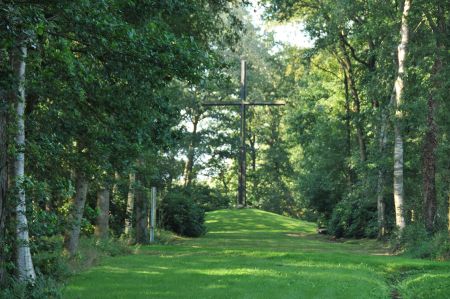 The Upschloot is the dam on which the old Frisian military road from Oldenburg to Jever crosses the border ditch between Harlingerland and Jeverland. In this once marshy landscape, the East Frisian geest turns into marshland.
The Upschloot is the dam on which the old Frisian military road from Oldenburg to Jever crosses the border ditch between Harlingerland and Jeverland. In this once marshy landscape, the East Frisian geest turns into marshland.
In the Middle Ages, the area was repeatedly the scene of bloody battles for supremacy over the Frisian "splendours". In 1600, Harlingerland became part of the county of East Friesland, which fell to Prussia in 1744.
Jeverland lost its independence to Oldenburg in 1575, to Anhalt-Zerbst in 1867 and to Russia in 1793. During Napoleon's time, the entire East Frisian peninsula belonged to Holland, then to France until Europe was reorganized at the Congress of Vienna in 1815. The ditch remained the state border; now he separated the Kingdom of Hanover from the Grand Duchy of Oldenburg.
The political changes of the 19th and 20th centuries changed the meaning of this border several times. Today the Upschloot connects the districts of Friesland and Wittmund as well as the churches of Oldenburg and Hanover.
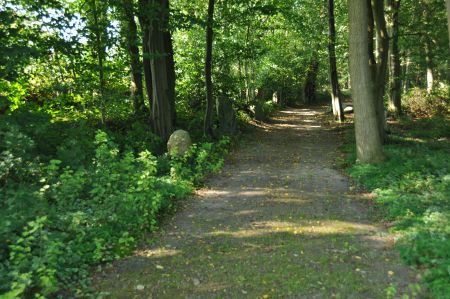 Under the impression of the Second World War and the inhuman violence of National Socialism, a group of those affected erected a cross at this historic site in 1948 as a memorial against any future war. In the melancholic landscape, it is a sign of Christian hope for peace that overcomes all borders.
Under the impression of the Second World War and the inhuman violence of National Socialism, a group of those affected erected a cross at this historic site in 1948 as a memorial against any future war. In the melancholic landscape, it is a sign of Christian hope for peace that overcomes all borders.
At the same time, the cross commemorates the people who lost their lives for political, racial and religious reasons. Boulders with the names of the Jeverland parishes line a small forest in which each tree stands for a war dead from the Cleverns-Sandel parish. Twice a year (Ascension Day 10:00 a.m., Sunday of the Dead 3:00 p.m.) a service is celebrated under the Jeverland memorial.
The facility, which is maintained by the Cleverns-Sandel volunteer fire brigade, invites passers-by to rest and contemplate at all times of the year.
- as far as the inscription on the information board -
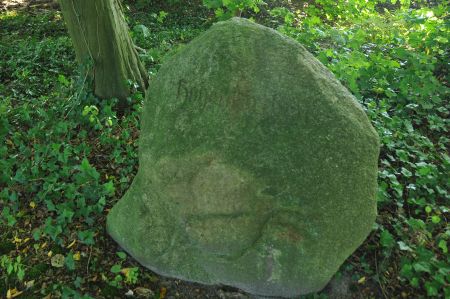 The last sentence in particular made us aware of the cycle path that runs along here, which suggested that bicycles were used frequently along the memorial. As in many regions of Germany, there is also an extensive network of cycle paths in Friesland / Ostfriesland, so that there are certainly frequent visitors here, which should be confirmed a few minutes later as correct. Finally, in a natural way, the site really seemed too well cared for to be just an isolated monument in the shape of a cross. However, we were not completely satisfied with the findings from the text above and already had an idea for further information: Joachim, who had often been available to us with in-depth specialist information from the region. Actually a war refugee from East Prussia, over the years Joachim has familiarized himself deeply with the circumstances and history of the Jever area. And of course, in this case, too, further information came together.
The last sentence in particular made us aware of the cycle path that runs along here, which suggested that bicycles were used frequently along the memorial. As in many regions of Germany, there is also an extensive network of cycle paths in Friesland / Ostfriesland, so that there are certainly frequent visitors here, which should be confirmed a few minutes later as correct. Finally, in a natural way, the site really seemed too well cared for to be just an isolated monument in the shape of a cross. However, we were not completely satisfied with the findings from the text above and already had an idea for further information: Joachim, who had often been available to us with in-depth specialist information from the region. Actually a war refugee from East Prussia, over the years Joachim has familiarized himself deeply with the circumstances and history of the Jever area. And of course, in this case, too, further information came together.
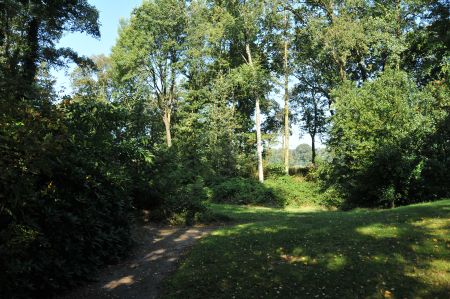 Joachim was also able to confirm that an oak tree had actually been planted on this spot for every war casualty from the Cleverns-Sandel community. The responsible organizer of this planting campaign so shortly after the Second World War was the owner and at the same time affected father Eberhard Hanken. At that time, he owned the meadow area on the L813, which has a slight right-hand bend at this point. Eberhard Hanken, who ran his farm here in Grappermöns as a farmer, had lost his son in the war, so his second child, a daughter, took over the farm, which, years later, was completely burned out.
Joachim was also able to confirm that an oak tree had actually been planted on this spot for every war casualty from the Cleverns-Sandel community. The responsible organizer of this planting campaign so shortly after the Second World War was the owner and at the same time affected father Eberhard Hanken. At that time, he owned the meadow area on the L813, which has a slight right-hand bend at this point. Eberhard Hanken, who ran his farm here in Grappermöns as a farmer, had lost his son in the war, so his second child, a daughter, took over the farm, which, years later, was completely burned out.
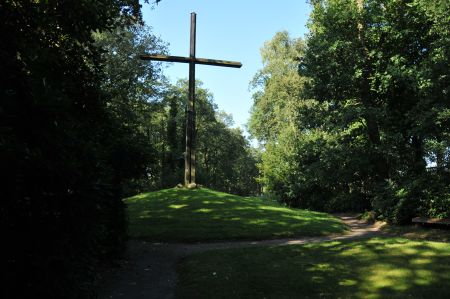 The loss of his son was then the starting point for severing the piece of willow in the form thrown up at the inflection point of the curve of the hills for the memorial. This made it possible to look at the memorial from both directions when driving along the route. Together with other families, the idea for the memorial was expanded and implemented in 1948. Today, 65 years later, the young tree seedlings have long since grown into strong, huge oaks that frame the wooden cross.
The loss of his son was then the starting point for severing the piece of willow in the form thrown up at the inflection point of the curve of the hills for the memorial. This made it possible to look at the memorial from both directions when driving along the route. Together with other families, the idea for the memorial was expanded and implemented in 1948. Today, 65 years later, the young tree seedlings have long since grown into strong, huge oaks that frame the wooden cross.
Please read as well:
